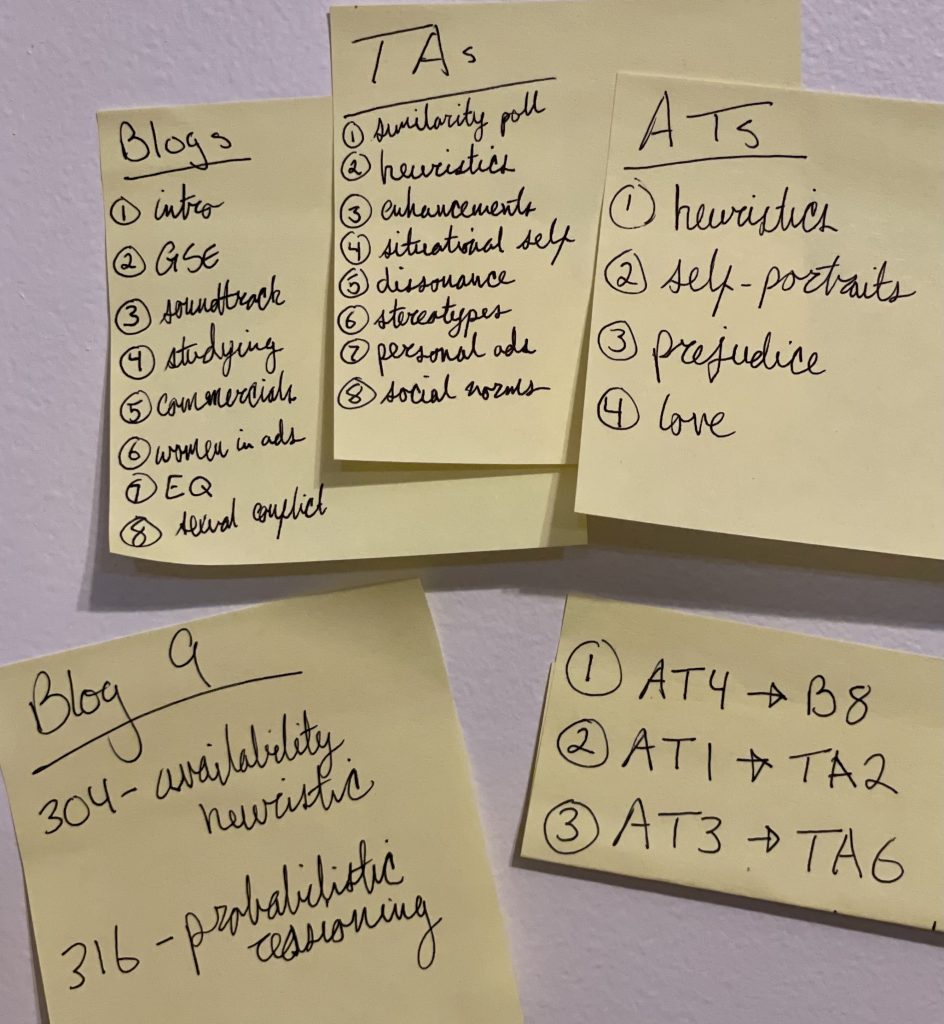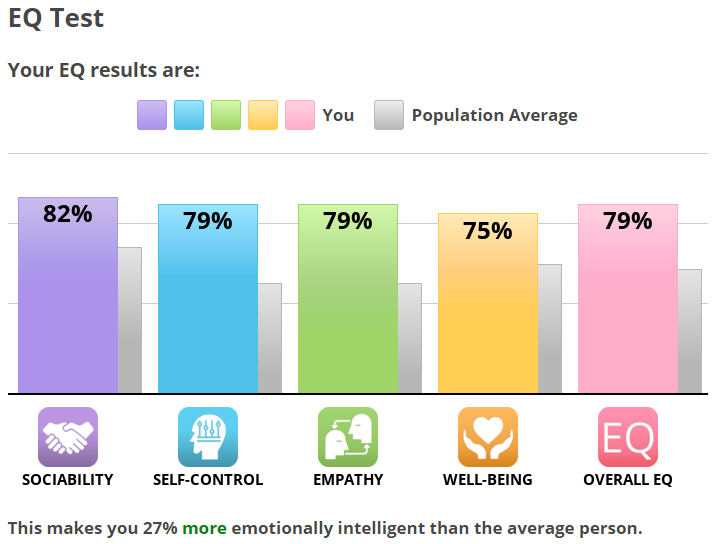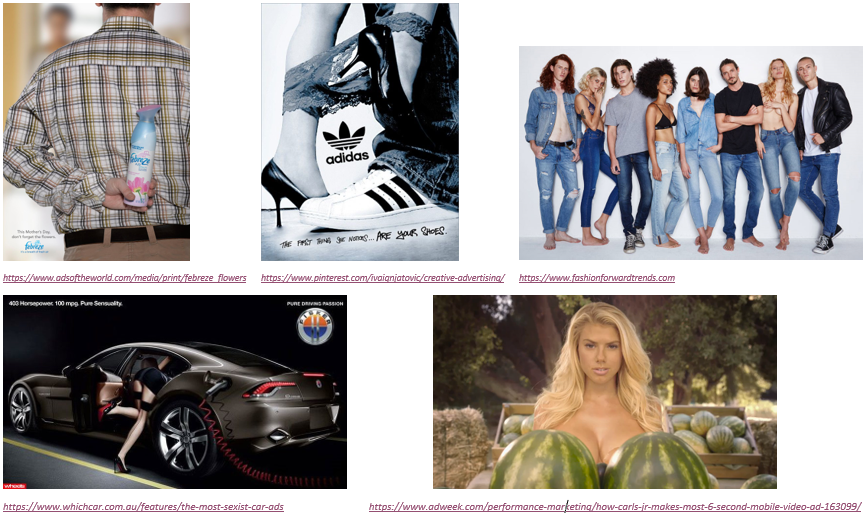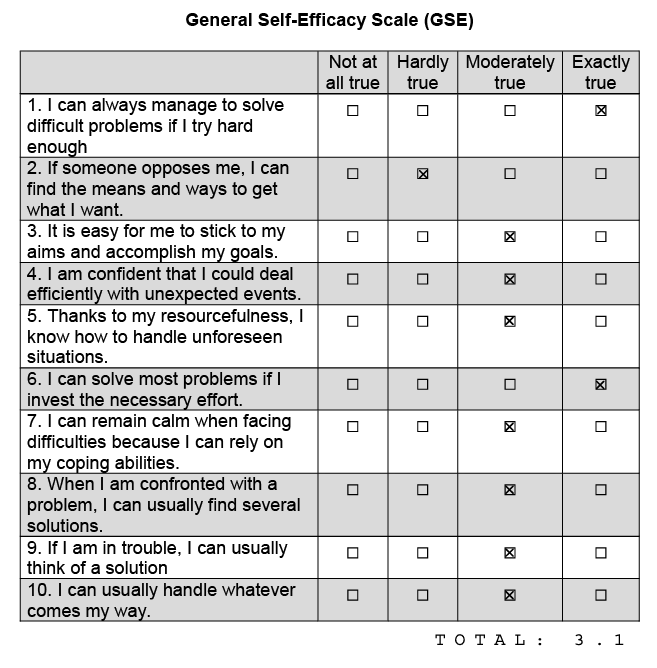BLOG 10
In the beginning of this course, I expected to simply gain a better knowledge of social behaviors. I wanted to develop some skills to identify and address social needs in my community as well. I would say that I have learned a great deal about social psychology. While I have not developed hand-on skills to address social needs, I have gained an understanding of various needs, as well as a better eye for determining them.
Our course syllabus lays out the objectives of the class. I feel as if I have done pretty well with the majority of these objectives. Though I have struggled with some (I think anyone would for any given course), I have been very successful in understanding how attitudes develop, how strong relationships are formed, and how to better recognize and understand prejudice.
When I think about how I felt about social psychology going in, and how I feel now, is where I have made the biggest change. I have always thought of social psychology as a field that presents fun and atypical circumstances in an attempt to see how others would respond. While this does happen, I have learned that it is more accurately described as a field looks to empirically find out why social circumstances come about, even if they are wildly uncomfortable.
If I could (or had to) take the class again, I would come in with a much better understanding that a big part of the class is uncomfortable scenarios. There is a lot of discussion violence against children, substance abuse, terrorism, and even sexual violence. I have never looked at these things through a scientific lens, which turned out to be very unsettling form me. I would come back in with a much better understanding of this and hopefully be able to approach these subjects with a clearer mind.
When it comes to academic growth over the semester, I would have to say that I have experienced quite a bit. I decided to take three classes this semester, which is less than full-time, but is quite a bit for a father of two young children, a full-time job, assistant flag football coach, and weekly sports podcast host. I have nearly zeroed in on the art of time management and learned a great deal of self-care, all while maintaining my love of learning new things.
In the end, I have developed many skills that I will be able to utilize. One skill I am most proud of is being able to better discuss prejudice. It is no secret that society everywhere is in need of growth in this particular area, and I am very fortunate to have had the opportunity to learn more about it and apply it professionally. I work with underprivileged children, and the majority of them and their families experience some sort of prejudice. Taking what I’ve learned from this class, I am able to better serve these families with sympathy and understanding as we work together to get them out of poverty and become independent.

https://thumbs.dreamstime.com/t/student-evolution-vector-occupation-vector-student-evolution-vector-107104271.jpg
BLOG 9
We have had the opportunity to learn about many areas of social psychology in our class; from heuristics to how women are depicted in advertising, from self-enhancements to social norms. Through this ePortfolio project, we are able to take deeper dives into these subjects and display them in a way that is interactive and educational. This is also a great way to provide and display information for others to see.
One submission I really enjoyed was Assignment Takeaway 1: Heuristics in Social Cognition. In this, we compared what we learned about heuristics and how we have become better-suited to recognize, and in some cases avoid, them. In my second Item to Archive, I spoke more in-depth about representativeness heuristics. Between the Item to Archive, Assignment Takeaway, and general reading, I feel that I came away with a great understanding about heuristics.
Another submission that stood out to me was Assignment Takeaway 3: Prejudice. The initial assignment had us take a look at a famous comedian having meltdown on-stage and using racially inappropriate language. We then had to assess whether the man was inherently racist, or just the words he was using. A good companion to this was my sixth Item to Archive. There we discussed the stereotypes of various nationalities, comparing the stereotypes between the 1930s, 1950s, and now. Between the two assignments, it is an interesting look into how groups are view and how anti-group comments and feelings can come about.
A third pair of assignments that I took a lot away from were Assignment Takeaway 4: Love and the previous blog to this one: Blog 8. For the takeaway, I analyzed my Hendrick & Hendrick’s Styles of Love assessment results and saw how I would be in a long-term relationship. In my blog, I looked at how men and women annoy each other. While some of this was amusing, I have been in a long-term relationship for quite awhile and found this to be an interesting way to view my relationship with my wife.
What has been really helpful throughout my ePortfolio are the ties between this class (PSYC 304 – Social Psychology) and others. In particular, availability heuristics and probabilistic trends in Scientific Reasoning in Psychology (PSYC 316). Availability heuristics are based off of recall, i.e., if we have recently seen a shark attack on the television, we will be concerned about going into the water on our beach trip. Probabilistic trends discusses finding trends in data and determining probabilities. Availability heuristics play a big role in in this area of reasoning, because they can make a trend seem apparent from recency, but doesn’t actually exist. It is fair to say that this ePortfolio project has helped to increase my understanding of content throughout all of my classes.

BLOG 8
Men and women in romantic relationships find themselves in sexual conflict rather regularly. Whether it be jealousy, skepticism, or deception, women have specific ways that they annoy men, and men have specific ways they annoy women. Men annoy women by spitting, “mansplaining”, trying to fix problems instead of simply listening to problems, wanting to do something away from the family unit, cursing, being loud, not giving full attention during a conversation, admiring other women, interrupting, and being overconfident. The list could continue. Women, on the other hand, annoy men by expecting men to know automatically that they are involved in a conversation, having double standards, presenting problems they do not want solutions for, expecting movie-quality scenarios to play out, starting project with no intention to finish, focusing on what men might be thinking, worrying about what others think in general, weaponizing emotions, dieting, and wanting to be together while he is very clearly in the middle of something. My intention is not to take away from the legitimacy of the conflicts between men and women, but this list does show how the two are very much different in their desires and expectations.

top: https://th.bing.com/th/id/R582b6df3bfc2ccda8538fc4eba572fee?rik=DXJp6Qe28vs9og&pid=ImgRaw
bottom: https://th.bing.com/th/id/R8f572bd8b6aab14c693722e5f81ea188?rik=UwrRYXZye%2fHxNg&riu=http%3a%2f%2fst3.depositphotos.com%2f6465874%2f14944%2fi%2f450%2fdepositphotos_149441068-stock-photo-man-looking-at-camera-woman.jpg&ehk=PKQRvU7DkRW%2bXFrqYYiyMH2fHU89r3QfcDnRd74xbbE%3d&risl=&pid=ImgRaw
BLOG 7
Self-regulation and emotional intelligence (EQ) go hand in hand. When one is able to appropriately self-regulate, they have a higher EQ score. To me, emotional intelligence is that ability to regulate your own emotions, be able to appropriately apply self-care, empathize with others, and recognize the emotion level of an individual or event.
I believe I have higher-than-average emotional intelligence. I am able to empathize with others and create a conversational space with others that allows them to be open and honest about difficult topics. I practice self-care, motivational interviewing, and active listening. I pay attention to and understand a wide variety of social situations, and I make sure I take my time to learn of those I don’t. With that being said, I could do much better with self-care. I believe in the concept that you can’t take care of others if you haven’t taken care of yourself, and I often find myself struggling to keep my own emotions in line while giving my all to others.
I found a very short EQ test from Individual Differences Research labs. The results are depicted below. The chart shows that I am above average in EQ, but also show that my self-reflection is lacking among the rest. While still above average, I need to take more time for self-reflection, work on recognizing my own feelings better, and not overextend myself for others as often as I do.

BLOG 6
The Ted Talk, The Dangerous Ways Ads See Women shines a bright light on the world of sexualized advertising. Jean Kilbourne provides historical and modern accounts of women, men, and children being objectified in print and media ads. While this happens less frequently now, this performance shows that advertising companies have gone to great lengths to hide their messages in sexualized and provocative ways in order to sell products. It is a sad and telling discussion that is clearly a global issue that still needs to be addressed.
Dehumanizing women in ads is not a new phenomenon, and modern ads are no exception. The most obvious that come to mind are sports betting ads, car ads, and the infamous Carl’s Jr. ads, which have hypersexualized women selling run-of-the-mill fast-food burgers. An example of Carl’s Jr. is depicted below. Magazines still print covers with scantily clad, seductive women on them, and fitness magazines continue to show both men and women with unnatural figures in a story while warning their readers of swimsuit season.
Jean Kilbourne goes into detail about the obvious sexualization, stereotyping, dehumanizing, and body distortion of women in advertising. What I found to be extremely interesting were the example of sexualizing males and children. Males are not dehumanized like their female counterparts, but there is a major trend in sexualizing them. However, this does not have the same negative effects on males as it does females (Kilbourne, 2014). Children are being advertised to like never before. In fact, Kilbourne discusses that advertising companies are targeting children as young as 6 months old; when they begin to recognize brand images (Kilbourne, 2014). If advertising companies are not kept in check, the same emotional setbacks that young women face now will continue to increase throughout the younger generations.
Below are five examples of relatively recent print ads that stereotype, sexualize, and dehumanize women. The first is a Mother’s Day ad from Febreze. It states, “This Mother’s Day, don’t forget the flowers.” The man is holding a can of flower-scented Febreze behind his back like a bouquet of flowers, suggesting that you should get your wife or mother cleaning products to make them happy.
The second is a shoe ad from Adidas. “The first thing she notices… are your shoes” is clearly printed below a couple in an embrace. While the male is fully clothed, and wearing the shoes being advertised, the female has her underwear wrapped around her ankles. Clearly sexualizing the woman and suggesting that sex is guaranteed if you purchase this iconic sneaker.
The next example is from a denim manufacturer with a group of several young men and women. The women are sexualized to the extent that all but one of them are topless, with one even covering her bare breasts. The young men are all fully clothed.
The fourth ad is for Fisker, a high-end electric sports car. This ad is beautifully done attempting to showcase such a nice car. However, in the open back seat, there is a woman’s rear end bent over in a very sexual, seductive, and vulnerable position. Simply unnecessary.
Finally, as mentioned earlier, a pretty standard Carl’s Jr, advertisement. The model in the ad is topless in what seems to be a farmer’s market filled with watermelon. There are two watermelon covering her naked breasts as an obvious innuendo. How does this sell burgers and fries? Obviously, it works, because many such ads on are television every year.
REFERENCES
Kilbourne, J. (Performer). (2014). The Dangerous Ways Ads See Women. Lafayette College. Retrieved March 2021, from https://www.youtube.com/watch?v=Uy8yLaoWybk

BLOG 5
Advertisements use many persuasive techniques to sell products or give information. These techniques can be credible, non-credible, or even use attractive material to elicit an emotion. I have found three advertisements that represent each of the previously stated concepts. Below, figures A, B, and C are from Squairz golf shoes, CNN, and Michelob Ultra respectively.
Figure A is from a golf shoe advertisement from Squairz. This is a non-credible source because the advertisement suggests that simply wearing the shoes will increase swing speed, help you create more torque in your swing, and increase your overall distance. They claim that the stability in the design is the cause. While stability is a factor in all aspects of these claims, rhythm, proper motion, and a balanced swing have significantly more to do with how straight and long a player hits a golf ball. Squairz is simply trying to sell a shoe with a different design.
In contrast, Figure B is an example of a credible source. CNN is a political network, and its advertisement to encourage mask-wearing to protect each other from COVID-19 simply states that wearing a mask is “not a political statement.” This goes against their own self-interest and points out that wearing a mask is not tied to a party affiliation. Furthermore, CNN is trustworthy organization with a good track record for self-reporting errors and participating in fact-checking. This affirms that the encouragement to wear masks comes with no ill-intent.
Figure C is a commercial ripe with attractive information. Michelob Ultra’s recent campaign to sell beer to highly active people is filled with messages and images indicating that drinking their beer, which is enticing on its own, has helped world-class athletes on their journeys to championships. This particular ad depicts the likes of Serena Williams, James Harden, Brooks Koepka, Arnold Palmer, and Peyton Manning. All of whom are world champions in their respective sports. Those who enjoy sports tend to revere these people and depicting them encourages regular consumers to be “just like them.” Admittedly, this is an effective add for myself.

BLOG 4
I could simply say that test-taking is not my forte, but we both know that probably isn’t true. My first exam in PSYC 304 did not yield the outcomes I had desired. Not for the fact that I am not good at taking tests, mind you, but because my study habits were less than desirable going in. Having the opportunity to review the exam later, I struggled mostly with ideas about mood and how they are expressed. This is one area that I somewhat took for granted and neglected to study as much as the other areas. I will say, however, that I am confident that I have good study habits, and the rest of my exam reflected this. I am very diligent to go through the study guides and fill in the information covered. I then break down the guide into sections (usually by chapter) and study one section per day leading up until the exam. These techniques allow me to get an idea of the materials covered and make sure I study the right sections, all while preventing me from getting burnt out from studying. I use these techniques in all of my classes, and I am very happy with the overall results. Moving forward, I plan to improve my results by getting a better night’s rest and eating better the day of my exams. I often take exams after a full day of work, and I believe this to be a detriment.

https://www.neatorama.com/2012/09/24/Why-Immigrant-Children-Do-Better-in-School/
BLOG 3
I believe it is commonly understood that music connects people. However, the concept that music is more attributed to values than personality is new to me. (Selterman, 2012) it could be the case that “getting your taste in music from your parents” is just another iteration of growing up with a core set of values. While that may be a stretch, it is very true that growing up, my core group of friends and I all had extremely similar taste in music. In fact, my wife and I met through our appreciation for certain bands. Our musical taste has changed as we have gotten older, but this article has shined a light on the common thread between our shared values and what we listen to.
I am someone who enjoys a wide variety of music. Because of this, the songs that I associate with important people in my life are widely dispersed. Both Champion by Kanye West and Here Comes the Sun by The Beatles represent my outlook on life: we can all overcome obstacles and appreciate the good. I have had many songs that I relate to my children, Dear Theodosia from Hamilton perfectly encompasses them both into one song. There are too many songs I could choose for my wife, but Arms of a Woman by Amos Lee and Blinding Lights by The Weeknd ring true the idea that my wife is my rock. Finally, my mother sang The River by Garth Brooks to me when I was little. This song is about chasing your dreams and taking risks, both of which I have tried to make an important part of my life.
REFERENCES
Selterman, D. D. (2012, February 21). “Soul Meets Body” – How Music and Relationships are Connected. Retrieved February 19, 2021, from Luvze.com: https://www.luvze.com/soul-meets-body-how-music-and-relationships-are-connected/
My Soundtrack:
Life Outlook – Champion (Kanye West) and Here Comes the Sun (The Beatles)
My Children – Dear Theodosia (Leslie Odom, Jr. and Lin-Manuel Miranda)
Spouse – Arms of a Woman (Amos Lee) and Blinding Lights (The Weeknd)
Childhood – The River (Garth Brooks)

BLOG 2
What kind of student am I? I believe I am a dedicated, hardworking, mildly disorganized, and curious student. I believe I am passionate about learning, as well as figuring out how to properly apply new content. I have a genuine interest in a plethora of subjects, allowing me to fully immerse myself in what I am learning.
Am I a confident student? My confidence as a student is somewhat of a paradox. While doing an assignment, for instance, I am extremely confident in my overall approach and execution. After submitting said assignment, however, my confidence level drops as my anxiety over good performance skyrockets. Candidly speaking, I do struggle with time management. As an online student, I have to create my own schedule. While this is simple in theory, I find myself having a hard time deciding how and when to approach multiple classes in the beginning of a semester. I have recently decided that spacing everything out does not work for me, and feel that a more structured, class-by-class approach throughout the week would greatly benefit me in terms of stress, anxiety, and overall academic performance.
I have filled out scored the General Self-Efficacy Scale (GSE) and received a score of 3.1. This is a higher-end score for self-efficacy, and I trust these results. I scored highest in solving difficult problems and solving most problems with necessary effort. I believe myself to be well equipped to solve difficult problems and I will always put in all my available effort to solve them. I had to be honest with myself to say that it was “hardly true” that I find the means to get what I want. While this may occasionally be true, I am more likely to “fall in line” instead of putting myself in a position to be opposed. The remainder of the GSE was scored at “moderately true”, which I think accurately depicts my levels of self-confidence and stick-to-itiveness, while also leaving open that I occasionally struggle with anxiety in my performance. The GSE appears to be a handy way of putting data behind how one approaches tasks.

BLOG 1
The course objectives for PSYC 304 will undoubtedly help me in the future. As a psychology major, and a hopeful mental health professional, learning how to hypothesize, test, decipher, and determine how and why people behave in social situations will allow me to make honest and fair assessments of others’ behaviors in the future. Being able to understand prejudice, relationships, and experience will further my abilities by allowing me to perceive social instances for what they truly are, instead of through pure speculation.
Through this course, I hope to gain knowledge and understanding about social behaviors. With this, I intend on developing the skills necessary to accurately address social needs among individuals and communities.
I will need to be able to implement several strategies throughout the course in order to be successful. I will also need to remain organized in my course materials and diligent in my assignments. More importantly, I will need to keep an open mind about how and why others act as they do. Failure to learn and accept the behaviors of others, simply because I do not care to truly understand, will prove to be a detriment.
Social psychology is of great interest to me, and I intend to learn and grow greatly during this semester.

Illustrating anchoring and adjustment of heuristics, this image is very good portrayal of the perceived value of something based on its anchored cost. The value is high because of discount at which it was purchased, even if the item itself is not truly valuable.